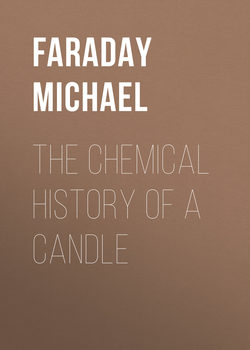The Chemical History of a Candle

Реклама. ООО «ЛитРес», ИНН: 7719571260.
Оглавление
Faraday Michael. The Chemical History of a Candle
PREFACE
THE CHEMICAL HISTORY OF A CANDLE
LECTURE I
LECTURE II
LECTURE III
LECTURE IV
LECTURE V
LECTURE VI
LECTURE ON PLATINUM
Отрывок из книги
I purpose, in return for the honour you do us by coming to see what are our proceedings here, to bring before you, in the course of these lectures, the Chemical History of a Candle. I have taken this subject on a former occasion; and were it left to my own will, I should prefer to repeat it almost every year—so abundant is the interest that attaches itself to the subject, so wonderful are the varieties of outlet which it offers into the various departments of philosophy. There is not a law under which any part of this universe is governed which does not come into play, and is touched upon in these phenomena. There is no better, there is no more open door by which you can enter into the study of natural philosophy, than by considering the physical phenomena of a candle. I trust, therefore, I shall not disappoint you in choosing this for my subject rather than any newer topic, which could not be better, were it even so good.
And before proceeding, let me say this also—that though our subject be so great, and our intention that of treating it honestly, seriously, and philosophically, yet I mean to pass away from all those who are seniors amongst us. I claim the privilege of speaking to juveniles as a juvenile myself. I have done so on former occasions—and, if you please, I shall do so again. And though I stand here with the knowledge of having the words I utter given to the world, yet that shall not deter me from speaking in the same familiar way to those whom I esteem nearest to me on this occasion.
.....
I have a drawing here, sketched many years ago by Hooke, when he made his investigations. It is the drawing of the flame of a lamp, but it will apply to the flame of a candle. The cup of the candle is the vessel or lamp, the melted spermaceti is the oil, and the wick is common to both. Upon that he sets this little flame, and then he represents what is true—a certain quantity of matter rising about it which you do not see, and which, if you have not been here before, or are not familiar with the subject, you will not know of. He has here represented the parts of the surrounding atmosphere that are very essential to the flame, and that are always present with it. There is a current formed, which draws the flame out—for the flame which you see is really drawn out by the current, and drawn upward to a great height—just as Hooke has here shewn you by that prolongation of the current in the diagram. You may see this by taking a lighted candle, and putting it in the sun so as to get its shadow thrown on a piece of paper. How remarkable it is that that thing which is light enough to produce shadows of other objects, can be made to throw its own shadow on a piece of white paper or card, so that you can actually see streaming round the flame something which is not part of the flame, but is ascending and drawing the flame upwards. Now, I am going to imitate the sunlight, by applying the voltaic battery to the electric lamp. You now see our sun, and its great luminosity; and by placing a candle between it and the screen, we get the shadow of the flame.
You observe the shadow of the candle and of the wick; then there is a darkish part, as represented in the diagram, and then a part which is more distinct. Curiously enough, however, what we see in the shadow as the darkest part of the flame is, in reality, the brightest part; and here you see streaming upwards the ascending current of hot air, as shewn by Hooke, which draws out the flame, supplies it with air, and cools the sides of the cup of melted fuel.
.....